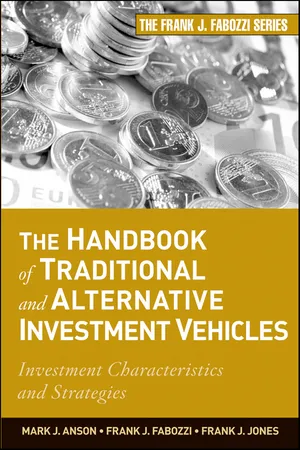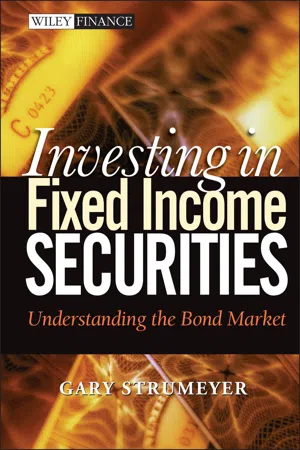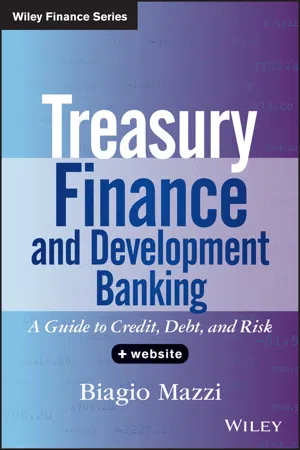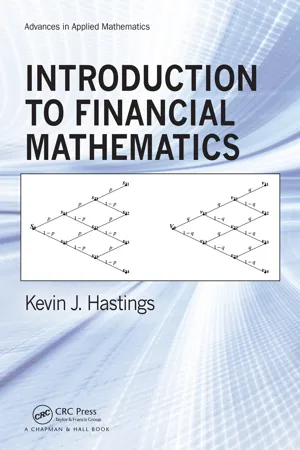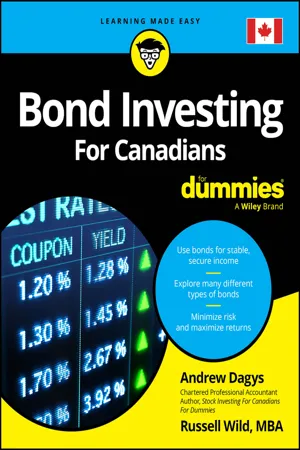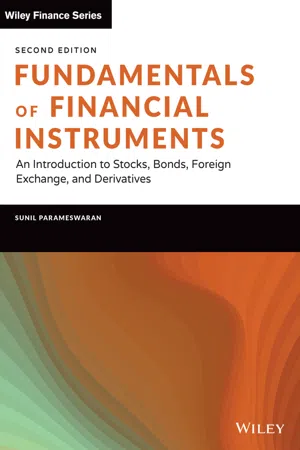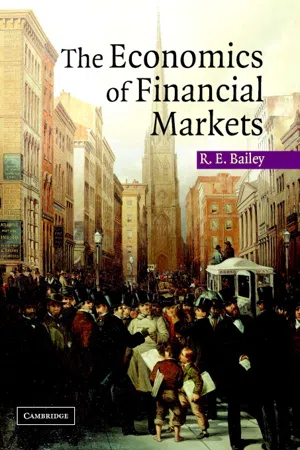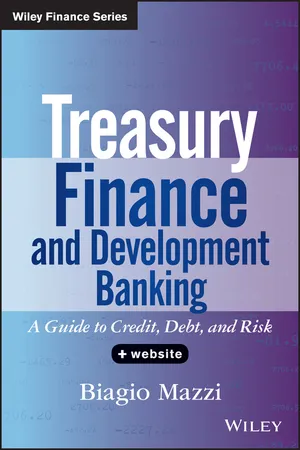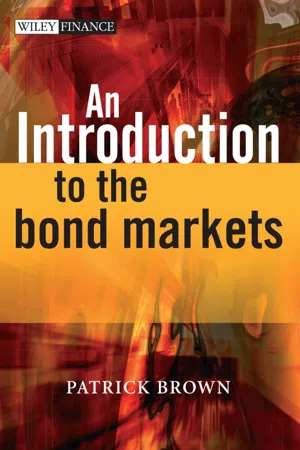Business
Bond Coupon
A bond coupon refers to the fixed interest payment that a bond issuer makes to bondholders at regular intervals, typically semi-annually or annually. The coupon rate is predetermined at the time of issuance and is based on the bond's face value. Bond coupons are a key source of income for bond investors and are an essential component of bond valuation.
Written by Perlego with AI-assistance
Related key terms
1 of 5
12 Key excerpts on "Bond Coupon"
- eBook - ePub
The Handbook of Traditional and Alternative Investment Vehicles
Investment Characteristics and Strategies
- Mark J. P. Anson, Frank J. Fabozzi, Frank J. Jones(Authors)
- 2010(Publication Date)
- Wiley(Publisher)
maturity value.Because bonds can have a different par value, the practice is to quote the price of a bond as a percentage of its par value. A value of 100 means 100% of par value. So, for example, if a bond has a par value of $1,000 and is selling for $850, this bond would be said to be selling at 85. If a bond with a par value of $100,000 is selling for $106,000, the bond is said to be selling for 106.Coupon Rate
The annual interest rate that the issuer agrees to pay each year is called the coupon rate. The annual amount of the interest payment made to bondholders during the term of the bond is called the coupon and is determined by multiplying the coupon rate by the par value of the bond. For example, a bond with a 6% coupon rate and a par value of $1,000 will pay annual interest of $60.When describing a bond issue, the coupon rate is indicated along with the maturity date. For example, the expression “5.5s of 2/15/2024” means a bond with a 5.5% coupon rate maturing on February 15, 2024.For bonds issued in the United States, the usual practice is for the issuer to pay the coupon in two semiannual installments. Mortgage-backed securities and asset-backed securities, that we cover in later chapters, typically pay interest monthly. For bonds issued in some markets outside the United States, coupon payments are made only once per year.In addition to indicating the coupon payments that the investor has contractually agreed to accept over the term of the bond, the coupon rate also affects the bond’s price sensitivity to changes in market interest rates. All other factors constant, the higher the coupon rate, the less the price will change in response to a change in market interest rates.There are bonds that have a coupon rate that increases over time according to a specified schedule. These bonds are called step-up notes - eBook - ePub
Investing in Fixed Income Securities
Understanding the Bond Market
- Gary Strumeyer(Author)
- 2012(Publication Date)
- Wiley(Publisher)
Chapter 2
The Basics of Debt Instruments
Michael BrunoBefore we move ahead, we should become familiar with common terminology used in describing bonds. In the beginning, the term fixed income securities was used to describe any investment vehicle that paid a fixed rate of interest to the investor over a clearly defined period. While that term is still the one used today to describe a whole plethora of investment vehicles, the term fixed income is somewhat of a misnomer. Some securities provide a variable rate of interest to the investor. Others provide no interest payments at all.Regardless of whether they are called fixed income securities, debt instruments, debt obligations, or the more regularly used term bonds , all have certain elements in common. Your journey toward understanding the structure, valuation, and analysis of bonds begins now.COUPON RATE
The rate of interest promised to the purchaser of a bond by the bond’s issuer is called the coupon . Why is it called a coupon? Some readers may remember a time when bonds were issued in the form of paper certificates. These bearer bonds were considered the property of whoever physically possessed them. Attached to the bottom of these bonds were small coupons that entitled the bearer to the interest payments of the bond. The bearer, who was presumed to be the owner, would clip the coupon that represented the next interest payment and send it to the bond’s trustee . (See Chapter 11 for more information regarding the function of the trustee.) The trustee, usually a large commercial bank, would then mail a check for that interest payment to the bearer. Nowadays, virtually all bond ownership is computerized and interest payments are made automatically to the registered bond owner of record. However, the term coupon has persisted to this day.The coupon interest rate is the contractual interest rate paid for the life of the instrument and is stated as an annual rate. Usually, the coupon interest is paid in annual, semiannual, or quarterly installments and the specific dates are based on the bond’s final payment date, known as the maturity date - eBook - PDF
Fixed-Income Securities
Valuation, Risk Management and Portfolio Strategies
- Lionel Martellini, Philippe Priaulet, Stéphane Priaulet(Authors)
- 2005(Publication Date)
- Wiley(Publisher)
2.3 Taxonomy of Rates There are a host of types of interest rates involved in the fixed-income jargon. It is very impor- tant that you obtain a good understanding of the meaning of each concept before you move further along. 2.3.1 Coupon Rate and Current Yield The coupon rate is the stated interest rate on a security, referred to as an annual percentage of face value. It is commonly paid twice a year (in the United States, for example) or once a year (in France and Germany, for example). It is called the coupon rate because bearer bonds carry coupons for interest payments. Each coupon entitles the bearer to a payment when a set date has been reached. Today, most bonds are registered in holders’ names, and interest payments are sent to the registered holder, but the term coupon rate is still widely used. It is essentially used to obtain the cash flows and shall not be confused with the actual current yield. The current yield y c is obtained using the following formula y c = cN P where c is the coupon rate, N is the nominal value and P is the current price. Example 2.15 A $1,000 bond has an annual coupon rate of 7%, so it pays $70 a year. If you buy the bond for $900, your actual current yield is 7.78% = $70 $900 If you buy the bond for $1,100, the current yield is 6.36% = $70 $1,100 In any event, the 7% coupon rate does not change. 2.3.2 Yield to Maturity The yield to maturity (YTM) is the single rate that sets the present value of the cash flows equal to the bond price. More precisely, the bond price P is found by discounting future cash flows back to their present value as indicated in the two following formulas depending on the coupon frequency: 50 Fixed Income Securities • When we assume that coupons are paid semiannually P = 2T t =1 CF t 1 + y 2 2 t the yield denoted by y 2 is expressed on a yearly basis with semiannual compounding where 2T is the number of semiannual periods. - eBook - PDF
Healthcare Finance
Modern Financial Analysis for Accelerating Biomedical Innovation
- Andrew W. Lo, Shomesh E. Chaudhuri(Authors)
- 2022(Publication Date)
- Princeton University Press(Publisher)
The reason they’re called “coupon” bonds is because, in the days before computers, bonds were physical pieces of paper to which coupons were attached. On specified dates, the owner of the bond would remove the coupon from the bond and present it to the issuer to get paid the interest due at that time. Today, the vast majority of these transactions are handled electronically, but the terminology remains, a quaint reminder of the 124 C H A P T E R 5 Year 0 1 2 3 $50 $50 $1,050 Face value = $1,000 Coupon = $50 Price = ? past. Some coupon bonds pay semiannually, and others pay quarterly. For expositional simplicity, we assume for now that coupon payments are made on an annual basis. For example, consider a 3-year bond with a face value of $1,000 and an annual cou- pon rate of 5% that has the cash flows illustrated in Figure 5.8. The coupon payment amount is calculated by multiplying the coupon rate, 5%, by the face value. In this example, the payment is 5% × $1,000 = $50. Note that on the bond’s maturity date, we receive our last $50 coupon payment plus the $1,000 face value payment. We can see already that, to value this bond today (Year 0), we’ll need to discount the cash flows by the appropriate spot interest rates. Assume that the 1-, 2-, and 3-year zero- coupon bonds have the prices and corresponding spot interest rates given in Table 5.2. Given these prices and rates, the price, P , of our coupon bond today in Year 0 will be given by the following present-value calculation: P = $50 1.0504 + $50 1.0553 2 + $1,050 1.0590 3 = $976.60 Equivalently, we can use the price of the 1-, 2-, and 3-year zero-coupon bonds rela- tive to their face values to directly determine the exchange rate between dollars today and dollars in the future. For example, in Table 5.2, the price of the 3-year zero-coupon bond tells us that $1,000 in Year 3 is worth $842 today in Year 0. - eBook - PDF
Treasury Finance and Development Banking
A Guide to Credit, Debt, and Risk
- Biagio Mazzi(Author)
- 2013(Publication Date)
- Wiley(Publisher)
Why is this important? We have stressed at length how, once we set ourselves the target of par value, the higher the coupon the larger the credit-driven correction needs to be and vice versa. Conversely, fixing the coupon price, different levels 134 TREASURY FINANCE AND DEVELOPMENT BANKING of corrections will lead to different bond prices. To think in terms of D i , however, is not easy. In its simplicity a bond yield allows us a very quick calculation (or at least a feel for the magnitude): knowing either only the bond price but not the coupon or only the coupon but not the bond price, the yield lets us estimate the other very quickly. For example, if a bond trades below par and the yield is y , then we know that the coupon c must be such that c < y . Conversely, if we know that a bond pays a coupon C and I know that the yield is such that C > Y , we also know that the bond trades above par. Let us stress the importance of the concept of yield by looking at the word itself. A bond can be roughly considered to be made of two parts, the principal and the coupon. The principal is the amount of money the investor lends to the borrower and is the main component of the deal, the coupon payments can be seen as the compensation the investor requires for delaying the consumption of the principal. 3 We have seen that the borrower sets the coupon by making sure that, once the bond is discounted and taking into account the market’s perception of the borrower’s own credit risk, the price is more or less par. This means that the coupon is the element taking care of the borrower’s credit. Bonds, however, can be very long dated instruments and between the time the coupon is set and a subsequent time, the credit standing of the borrower might change, making the coupon value irrelevant as a credit signal. Moreover, irrespective of the price paid for the bond, at maturity the investor receives the full principal amount, the unit of measure being the principal amount. - Available until 7 Feb |Learn more
- Kevin J. Hastings(Author)
- 2015(Publication Date)
- Chapman and Hall/CRC(Publisher)
Coupon rate or interest rate Coupon rate or interest rate Coupon rate or interest rate -Rate of interest used to calculate coupon pay-ments. Bond period Bond period Bond period -Time between coupon payments. Maturity date Maturity date Maturity date ( term to maturity term to maturity term to maturity ) -When the bond is scheduled to be redeemed. Redemption amount Redemption amount Redemption amount -What the holder receives when the bond is redeemed, usu-ally the same as face amount. Current bond price Current bond price Current bond price -What the bond is selling for on the market. Yield rate Yield rate Yield rate -Rate of return j that makes the current price equal to the present value of the stream of payments. 2.1. BOND VALUATION 117 Bond bought at a premium Bond bought at a premium Bond bought at a premium -Bond price exceeds face value. Bond bought at par Bond bought at par Bond bought at par -Bond price equals face value. Bond bought at a discount Bond bought at a discount Bond bought at a discount -Bond price is less than face value. Treasury bills Treasury bills Treasury bills -Short-term, zero-coupon U.S. debt obligations. Treasury notes Treasury notes Treasury notes -U.S. coupon bonds with maturities ranging from 2 to 10 years. Treasury bonds Treasury bonds Treasury bonds -Long-term coupon bonds. Premium discount form Premium discount form Premium discount form -The formula F + F ( r − j ) a n ⌉ j for the intial bond price that shows how the relation between the coupon rate and the yield rate deter-mines whether the bond is sold at a discount or not. Makeham’s formula Makeham’s formula Makeham’s formula -The issue price of the bond in the form K + r j ( F − K ), where K is the present value of the redemption amount. - eBook - PDF
- Andrew Dagys, Russell Wild(Authors)
- 2023(Publication Date)
- For Dummies(Publisher)
68 PART 1 A Quick Guide to the Fixed-Income Universe Understanding (and Misunderstanding) the Concept of Yield Okay, time to hold onto your hat. Now that you know something about research- ing the particulars of a bond offering and the climate of the bond market, it’s time to talk yield. Yield is what you want in a bond. It’s income, and it contributes to return. But yield is also confusing for some of us. People — including overly eager bond salespeople — often misuse the term or use it inappropriately to gain an advantage in the bond market. Don’t be a yield sucker. Understand what kind of yield is being promised on a bond or bond fund, and know what it really means. Coupon yield This one is easy. The coupon yield, or the coupon rate, is part of the bond offering. A $1,000 bond with a coupon yield of 4 percent is going to pay $40 a year. A $1,000 bond with a coupon yield of 6 percent is going to pay $60 a year. Usually, the $40 or $60 or whatever is split in half and paid out twice a year on an individual bond. Bond funds, whether in the form of mutual funds or ETFs (exchange-traded funds) don’t really have coupon yields, although they have an average coupon yield for all the bonds in the pool. That average tells you something, for sure, but you need to remember that a bond fund may start the year and end the year with a completely different set of bonds — and a completely different average coupon yield. Current yield Like coupon yield, current yield is easy to understand, at least on a superficial level. But a deeper level exists, and because of that, current yield is the most often misused kind of yield. In short, current yield is derived by taking the bond’s coupon yield and dividing it by the bond’s price. Suppose you had a $1,000 face value bond with a coupon rate of 5 percent, which would equate to $50 a year in your pocket. - eBook - PDF
- Robert Zipf(Author)
- 2003(Publication Date)
- Academic Press(Publisher)
You should know how bonds are described and how bond prices are expressed. You should understand how some bond features may affect bond prices, and you should have some understanding of how to estimate bond prices, and the effects of some bond features, without actually doing calcula-tions. You should understand some of the regulatory requirements for some bond price calculations and how to get help in meeting these requirements. Finally, you should understand how to accrue discount and amortize premium. WHAT IS A BOND? A bond consists of a principal amount, usually approximately the amount bor-rowed, together with periodic interest payments until the principal amount is 104 Bond Price Calculation repaid, together with the last interest payment. The date on which the princi-pal amount is repaid is called the maturity date of the bond, and the bond is said to mature on that date. The periodic interest payments are also called the coupon payments, or coupons. The income from the coupon payments is called the coupon income. The frequency of coupon payments usually depends on the country of issuance. In the United States, coupons are almost always paid semiannually. In most European countries, they are paid annually. Other countries may have other payment periods. For example, the United States Treasury has a bond outstanding that matures on August 15, 2029. It carries a coupon rate of 6.5%. This bond, like almost all bonds issued in the United States, pays interest semiannually. It is issued in multiples of $1,000, with a minimum amount of $1,000. This means that the bond will pay interest of $65 per year on a $1,000 bond. The interest will be paid in two installments, of $32.50 each, on February 15 and August 15, until August 15, 2029. On August 15, 2029, the last interest payment of $32.50 will be paid, along with the $1,000 of maturing principal. - eBook - PDF
Fundamentals of Financial Instruments
An Introduction to Stocks, Bonds, Foreign Exchange, and Derivatives
- Sunil K. Parameswaran(Author)
- 2022(Publication Date)
- Wiley(Publisher)
TERMS USED IN THE BOND MARKET Face Value The face value, also known as Par value Redemption value Maturity value Principal value is the principal amount underlying the bond. It was the amount raised by the issuer from the first holder and is the amount repayable by the issuer to the last holder. We will denote it by the symbol M. Term to Maturity This is the time remaining in the life of the bond as measured at the point of evalua-tion. It may be perceived as the length of time after which the debt shall cease to exist, and the borrower will redeem the issue by repaying the holder. It may also be viewed as the length of time for which the borrower has to make periodic interest payments on the debt. The words maturity , term , and term to maturity are used interchangeably. We will assume that we are stationed at time zero and will denote the point of matu-rity by T. Thus, the number of periods until maturity is T, which is normally measured in years. Coupon The contractual interest payment made by the issuer is called a coupon payment. The name came about because in the earlier days, bonds were issued with a booklet of Valuation of a Bond 137 post-dated coupons. On an interest payment date, the holder was expected to detach the relevant coupon and claim his payment. The coupon may be denoted as a rate or as a dollar value. We will denote the coupon rate by c . The dollar value, C , is therefore given by c × M . Most bonds pay interest on a semiannual basis and consequently the semiannual cash flow is c × M /2. Consider a bond with a face value of $1,000, which pays a coupon of 8% per annum on a semiannual basis. The annual coupon rate is 0.08. The semiannual coupon payment is 0.08 × 1,000/2 = $40. Yield to Maturity Like the coupon rate, the yield to maturity is an interest rate. The difference is that while the coupon rate is the rate of interest paid by the issuer, the yield to maturity (YTM) is the rate of return required by the market. - eBook - PDF
- Roy E. Bailey(Author)
- 2005(Publication Date)
- Cambridge University Press(Publisher)
The existence of coupons complicates the analysis, partly because a bond’s yield will depend on the amount of its coupon but also because the definition of ‘yield’ is itself more problematical. Consider a bond that promises to pay to its holder a coupon of c per year for n years plus the face value, m , when the bond terminates at maturity. If the current market price of the bond is p , then its yield to maturity , y , is defined as the solution to p = c 1 + y + c 1 + y 2 + c 1 + y 3 +···+ c + m 1 + y n (12.6) The yield to maturity can be understood as the internal rate of return on the bond. Notice that both p and y depend upon: (i) the time to maturity, n ; (ii) the coupon, c ; and (iii) the face value of the bond, m . This dependence has been suppressed 9 Formally, y 10 = 100 52 1 / 10 − 1 ≈ 0 068, and y ∗ 10 = 100 78 1 / 10 − 1 ≈ 0 025. 292 The economics of financial markets in the notation to avoid clutter. 10 But it should be emphasized that the prices (and yields) of bonds with different n , c and m will almost certainly differ among one another. While this is not explicit in the notation, it should be clear from the context. It is sometimes convenient to simplify (12.6) as p = c y 1 − 1 1 + y n + m 1 + y n (12.7) (See appendix 12.1.1 for the derivation of (12.7).) For coupon-paying bonds – unlike those with c = 0 – an explicit algebraic formula for y is unavailable except for special cases (in particular, when n < 5). But, if all coupons are non-negative, a unique solution exists and can be found by numerical methods. The yield to maturity on a coupon-paying bond does not have the same inter-pretation as the spot yield on a ZC bond. In particular, it need not be the case that the rate of return from holding a coupon-paying bond from the present until maturity equals the value of y that satisfies (12.6). Why not? Because the stream of coupons received between the date of purchase and maturity may, of necessity, be reinvested at rates different from y . - eBook - ePub
Treasury Finance and Development Banking
A Guide to Credit, Debt, and Risk
- Biagio Mazzi(Author)
- 2013(Publication Date)
- Wiley(Publisher)
Y , we also know that the bond trades above par.Let us stress the importance of the concept of yield by looking at the word itself. A bond can be roughly considered to be made of two parts, the principal and the coupon. The principal is the amount of money the investor lends to the borrower and is the main component of the deal, the coupon payments can be seen as the compensation the investor requires for delaying the consumption of the principal.3We have seen that the borrower sets the coupon by making sure that, once the bond is discounted and taking into account the market’s perception of the borrower’s own credit risk, the price is more or less par. This means that the coupon is the element taking care of the borrower’s credit. Bonds, however, can be very long dated instruments and between the time the coupon is set and a subsequent time, the credit standing of the borrower might change, making the coupon value irrelevant as a credit signal. Moreover, irrespective of the price paid for the bond, at maturity the investor receives the full principal amount, the unit of measure being the principal amount. Here is where the yield plays a crucial role in telling how much the investment is really yielding. If an investor pays 95 for a bond with a 5% (of 100, of course) annual coupon, then the investment yields more than simply 5%.For the most liquid bonds the yield plays such an important role that it can be traded alongside the bond price (not separately, of course, as the trader chooses to quote one or the other). 5.2.3 DurationWe have not mentioned up to now in any context the concept of sensitivity, that is, the impact of the price of a financial instrument due to a small movement in one of the variables leading to its value. This, of course, is very important in finance as it constitutes the foundation of replication, hedging, and risk-neutral pricing. In the interest rate world the most important of these sensitivities is the PV01 - eBook - PDF
- Patrick J. Brown(Author)
- 2006(Publication Date)
- Wiley(Publisher)
This could be a property and could be worth more than the capital lost. Many eurobonds just specify in their prospectus a ‘negative pledge’. As discussed later, this is just a pledge not to issue bonds in the future with a prior call on the assets of the company. However, in Europe it often does not stop the company taking out a bank loan that has a higher call on the assets. 30 An Introduction to the Bond Markets What is the coupon going to be on the bond? The bond could have a fixed-rate coupon, a floating-rate one, an index-linked coupon or no coupon at all. Depending on the investor’s requirements, some of these options may not be appropriate. For example, a zero-coupon bond is not appropriate for an investor who wants a regular income, but it might be ideal for a pension fund or insurance company manager that has a future liability that coincides with the redemption of the bond. What is the coupon payment frequency of the bond? A bond that pays quarterly is worth more than one that pays semi-annually, which in turn is worth more than one that only pays interest once a year, as you get the coupons earlier. What is the investor’s expected direction of interest rates and over what time horizon? If you expect interest rates to fall then purchasing a fixed-rate issue could be preferable to a floating-rate note, for with the latter your income will fall. Other things being equal, if your prediction is correct, the capital value of the fixed-rate issue should rise, which will not be the case with the floating-rate note. What is the period of the loan? Although most loans specify a final maturity date, the terms of the loan sometimes allow the issuer or the investor to demand an earlier redemption. What is the duration of the loan? This is different to the period of the loan. For example, compare a zero-coupon 10 year bond where you do not get any money back for 10 years with a 10 year bond that has an 8 % coupon.
Index pages curate the most relevant extracts from our library of academic textbooks. They’ve been created using an in-house natural language model (NLM), each adding context and meaning to key research topics.
